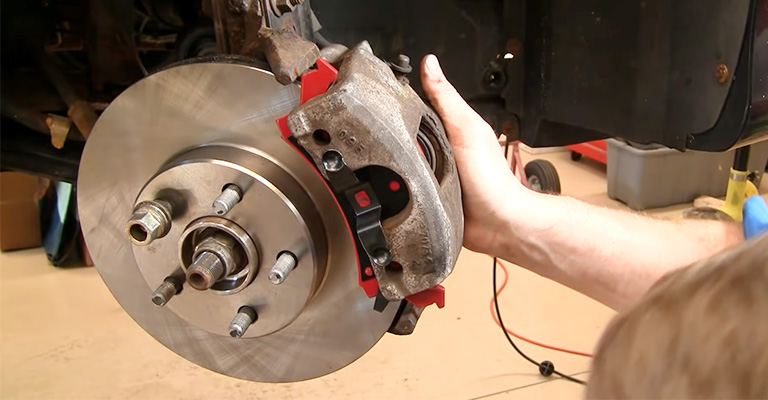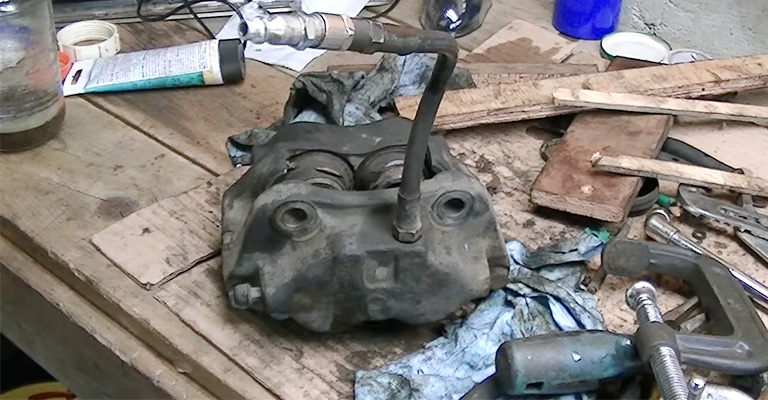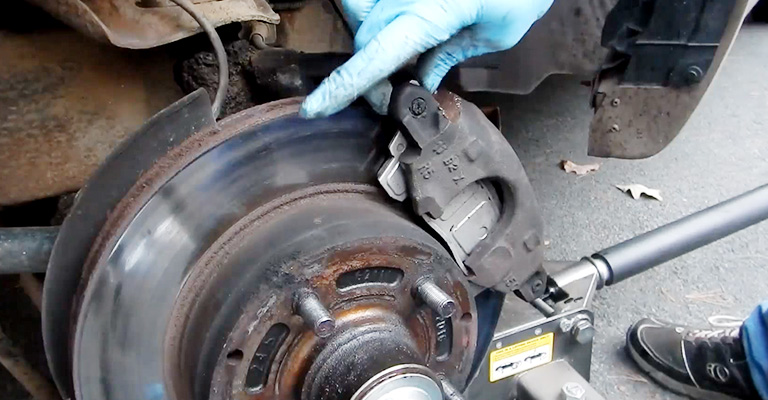Faulty brake calipers can be a major safety hazard and make your vehicle difficult to control. Therefore, it is important to know how to tell if your brake caliper is bad, so how to tell if brake caliper is bad? The failing symptoms.
Decreased stopping power, fluid leaks, and a pulling sensation to one side are all indicators of a faulty brake caliper. Calipers should last the vehicle’s lifetime, as opposed to brake pads, which must be replaced frequently.
Knowing the signs of a failing brake caliper is key to staying safe on the road. Learn the common symptoms of a bad brake caliper to remain alert to any issues and prevent disasters.

The Symptoms of A Faulty Brake Caliper
Brake calipers are crucial in keeping your car running safely and smoothly. So if you’re noticing signs of a problem with your brake caliper, it’s important to check it out ASAP.
Here are the warning signs of a faulty brake caliper to look out for:
- Unusual noises are coming from the brakes. A poorly functioning caliper can cause tapping, squealing, or grinding noises during braking.
- Brake fluid leak. This can signify a faulty brake caliper seal, allowing fluid to escape and reducing braking performance.
- Brake pad wear rates. If your brakes are wearing out too quickly, it could be due to a leaky cylinder or uneven pressure from the caliper onto the pad.
- Vibration in the brake pedal. Uneven braking or an ill-fitting caliper can cause vibration in the brake pedal.
- Excessive heat. This can often be due to friction between the brake pads and the caliper, leading to premature wear.
- Abnormal vehicle movement during braking. If you feel your car weave or jerk when you apply the brakes, it could be a sign of an ill-fitting caliper.
- Difficulty braking. If your car is taking longer than usual to stop, or if you have to push the brakes harder than expected, it could be a sign of a potential problem with the brake caliper.
- Pulling to the side when braking. Uneven braking pressure caused by a faulty caliper can lead to your car pulling to the left or right when you press the brakes.
- Brake light warning. Sometimes, a faulty caliper can trigger a warning light on the dashboard.
- Poorly aligned wheels. Sometimes, a misaligned caliper can cause the wheels to appear out of alignment.
If you notice any of these symptoms, it’s important to have your vehicle inspected as soon as possible. A faulty brake caliper can quickly lead to dangerous driving situations, so make sure you get it checked and repaired as quickly as possible.
The Reasons for A Faulty Brake Caliper

A faulty brake caliper is one of the most common issues and is often caused by different factors.
Knowing the reasons for a defective caliper can help you determine what is going on and help you get your brakes repaired as soon as possible.
Here are the most common reasons for a faulty brake caliper:
- Worn Brake Pads: If your brake pads are worn or not in good condition, the caliper may not function properly and create noise or cause uneven braking.
- Damaged Caliper Pistons: The caliper pistons, which could be steel or aluminum, may become damaged over time, leading to an inability to move freely.
- Obstructed Brake Discs: The brake discs may become stuck due to rust and dirt between the brake pads and the disc, causing the caliper to become stuck.
- Leaking Fluid: Seals and gaskets on the brake caliper may become loose or worn over time, leading to fluid leakage. This could cause the caliper to seize up.
- Frozen Pistons: Caliper pistons may freeze up due to rust, dirt, or corrosion, preventing them from moving freely.
- Faulty Mounting Brackets: The mounting brackets on the caliper may become loose or rusty, making it hard to hold the caliper.
- Badly Adjusted Caliper: If the caliper is not adjusted correctly, it may cause the caliper to become misaligned and lead to braking issues.
- Damaged Caliper Bolts: The bolts and nuts on the caliper may become worn or damaged, causing them to lose or fall off.
- Worn Caliper Bushings: Over time, the bushings on the caliper may become weakened or worn, causing it to cause erratic movement.
- Incorrectly Fitted Pads: If the brake pads are not correctly fitted into the caliper, it could lead to issues with the caliper not working correctly and causing uneven braking.
- Malfunctioning ABS: A malfunctioning ABS may lead to the accelerated wear of brake calipers due to too much pressure or incorrect brake pressure distribution.
If any of the above issues are present, it is important to get your brake caliper checked and replaced or repaired as soon as possible to ensure the safety of you and all other drivers on the road.
How To Troubleshoot a Faulty Brake Caliper?

When troubleshooting any part of your car, it’s important to understand the mechanical components involved. Paying close attention to the details can help save time and money.
Your car’s braking system is one of the most important parts of your vehicle, so a faulty brake caliper, if left unnoticed, can spell disaster in the form of an accident or vehicular damage.
Fortunately, troubleshooting a faulty brake caliper is not as daunting a task as one may think and can be done with a few simple steps outlined below.
- Verify the Symptoms: The cause of a faulty brake caliper can range from dirt and debris impeding fluid flow to the caliper to piston seals going bad.
Symptoms of a defective brake caliper can include a grinding noise when brakes are applied, a brake pedal that is hard to press, or vibrations coming from the front wheels when brakes are applied.
- Check for Damaged Seals: Once the caliper is determined to be the source of the problem, any rust, tears, or holes should be carefully examined. Piston seals should be inspected for gaps or wear to determine if they need to be replaced.
- Inspect the Brake Pads: Examine the brake pads for wear and see if they are evenly distributed or if the wear is concentrated in one area. If the pads are worn down or uneven, it may signify a faulty caliper.
- Check the Brake Fluid: Check to see if the brake fluid is discolored or has debris. This can indicate that the caliper may be leaking fluid and should be replaced as soon as possible.
- Unfasten the Brake Caliper: After identifying the faulty caliper, unbolt it from the brake assembly to gain access.
- Clean the Brake Caliper: Carefully clean the caliper, especially around the piston, with brake cleaner and a soft cloth.
- Re-install the Brake Caliper: Reinstall the caliper to the brake assembly and use a torque wrench to ensure that it is tightly secured enough and that there is no risk of over-tightening or under-tightening.
- Test the Brakes: Once the brake caliper is secured, it is time to perform a test drive to ensure the brakes respond properly.
- Bleed the Brakes: If the test drive was successful, go ahead and remove any old brake fluid and replace it with fresh brake fluid.
- Enjoy Your Ride: After finishing the troubleshooting and repairs, you can know that the brakes are working properly.
Troubleshooting a faulty brake caliper can seem daunting, but anyone can do it with mechanical know-how and patience.
By following these steps, you can rest assured that you’re helping to protect yourself and other motorists by ensuring that your vehicle performs properly.
FAQs
When Should I Get a New Set of Calipers?
It’s more challenging to pinpoint when exactly brake calipers should be replaced than it is with brake pads. Brake calipers have a much longer lifespan when properly adjusted and functioning than brake pads.
Damage to your calipers can be caused by something as minor as a piece of debris or as significant as an unusual braking incident. You should check the calipers every time you change the brake pads.
Should I Replace or Rebuild My Brakes?
Rebuild kits for calipers are readily available for most vehicles. On the other hand, a new caliper won’t set you back as much as an entirely new engine or transmission would.
Modern calipers are inexpensive enough to make buying a complete caliper preferable to purchasing a rebuild kit. Rebuilding a caliper usually involves replacing pin sleeves, guide pins, pistons, and seals.
How Do I Keep a Floating Caliper?
Floating calipers, in particular, are prone to sticking and seizing if they are not regularly oiled. It is important to check your floating caliper regularly and lubricate it with brake fluid to avoid the caliper pin sticking.
Avoid costly repairs to your entire caliper and premature brake pad wear by following this straightforward maintenance recommendation.
Final Thoughts
Discover how to tell if the brake caliper is bad. The failing symptoms indicate a bad caliper, such as grinding and squealing noises, difficulty stopping the vehicle, and more.
After reading this, you should better understand how to tell if your brake caliper is bad. If any of these symptoms are present, rebuilding or replacing the brake caliper as soon as possible is important to ensure safety.
Leave a Reply